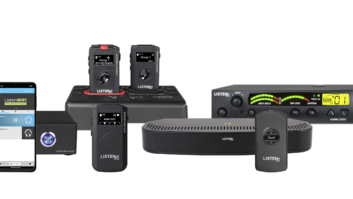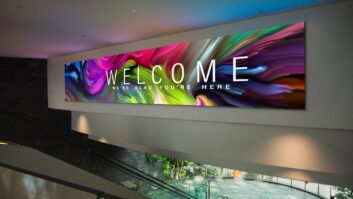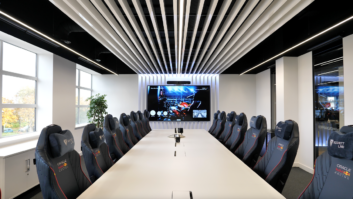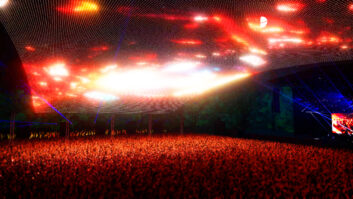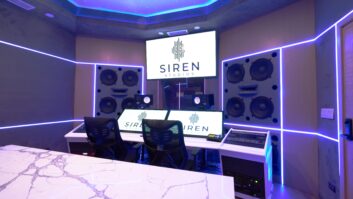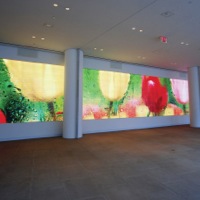
It is generally agreed that the first videowalls appeared in the early 1980s. Back then, they comprised arrays of CRT monitors – and, as such, there was almost as much visible gap between images as there was picture. Beyond this, the computer technology needed to split an image across multiple screens was both rudimentary and expensive.
Fast forward 30 years, and what’s changed? “The most significant change has been the introduction of the ‘super-narrow bezel’ class of LCD videowalls,” says Steve Seminario, who is a senior director of product marketing with Planar Systems. “All the other related technologies have been secondary contributors by comparison.”
Certainly, super-narrow bezel – SNB – displays are helping transform the videowall market. For the past decade and beyond, users wanting a seamless display with almost no visible gap between screens have turned to projection cube technology, which delivered (and continues to deliver) leading-edge image quality – but at the cost of expense and bulk. With SNB flatpanel displays, the perceived image is almost as good – and comes at a lower price while being easier to install. Those factors are helping the videowall market grow rapidly.
“Rear projection is still by far the dominant technology in the control-room sector – and will remain so – but SNB LCD display walls are gaining popularity, particularly in training rooms and crisis suites,” notes Peter van Dijk, business development manager at Mitsubishi Electric Europe. “LCD is not so suited to mission-critical facilities, but it’s a practical and cost-effective technology for many data visualisation and monitoring applications.”
“We also see excellent growth opportunities for SNB tiled displays in public display, retail and transportation,” he continues. “Their compact profile is a far more practical proposition compared to rear projection. We’ve seen strong growth here in Scandinavia and Russia over the past 18 months.”
“Many of our projects have been coming from the retail sector, with the use of SNB displays increasing over the past year,” says Chris Bartram, managing director of Crystal Display Systems, which designs, distributes and integrates flatpanel display solutions. “Samsung’s 40in and 46in SNB LED panels have become more affordable compared with the standard bezel displays.”
illuminating change
For many, the introduction of LED illumination in flatpanel displays has been no less significant than the development of SNB, given the impact it has on depth and weight, and thus the number of locations in which videowalls can be installed. NEC’s corporate sales manager Guy Phelps notes that LED illumination also consumes less power and generates less heat, making it a greener solution – a position reinforced by the need for less packaging.
“Interestingly,” says Phelps, “for large-scale tenders, the customer will request that the product is delivered with minimal packaging with no manuals or booklets included in order to reduce waste, often paying more per unit upfront to achieve these requirements in order to save the cost of disposal.”
Evolution – or revolution?
But, as Eric Hénique, director of marketing and international sales at eyevis, points out, the majority of changes in the videowall market have been evolutionary rather than revolutionary. “There has not been too much new in terms of technology in recent years,” he says. “It’s been more about improvements to existing products, such as the change to LED for cube light sources, smaller rear-projection devices, narrower bezels, higher resolutions, larger diagonals, more uniform appearance and so on.” He notes the advent of products such as eyevis’s omniSHAPES and squareTILES, although most consider tiled display technology as serving a different market to the videowall market.
If there is an exception to the incrementalism that Hénique believes he sees, it’s Prysm’s LPD (Laser Phosphor Display) technology which was launched as recently as January 2010 and which is already making inroads into the videowall market – notably, as the company’s vice president for EMEA, Steve Scorse, claims, with the largest videowall in the US. The installation in question is at IAC’s HQ in New York, and is 120ft wide.
But slim, lightweight, seamless displays count for nothing without the ability to drive them – a point well made by Barco’s Peter Bussens, who is market director, control rooms. “The capabilities of a display wall system are mostly determined by the controller infrastructure driving the display and the software that allows interacting with the visualisation system,” he says. “Videowall management software is growing from software intended purely for organising content on a large screen into a fully networked visualisation and collaboration solution.”
“Graphics cards are more powerful and provide higher resolution at higher frame rates over modern, high-rate interfaces such as HDMI and DisplayPort,” adds Arndt Schrader, product manager at RGB Spectrum. “The need for security is increasing, as is the need to display more information in the same space. Lastly, there is also a need to display more video at higher quality, especially in verticals such as transportation and security. All this leads us to believe that embedded, high-capacity display processors are perfectly positioned.”
“What that means is that control of videowalls is also undergoing a fundamental change,” he continues. “Technology allows a given operator to take on more responsibility while making higher-quality decisions – for example, control a larger geographic area of the power grid or control more computer sources. However, technology is only effective if it doesn’t get in the operator’s way. Consequently, RGB Spectrum developed its MultiPoint Control Room Management System, MCMS, which allows any operator to intuitively control any source and display it anywhere on the system, in a collaborative environment.”
For Mitsubishi’s van Dijk, modularity has been an important development: his company’s Seventy Series is specifically designed to make it easier and more cost-effective for integrators to deliver and support display wall systems in a wider number of applications. He also notes that Mitsubishi’s OLED technology has been gaining ground.
And while it’s not a technology trend as such, Prysm’s Scorse notes the growing significance of energy efficiency. “A 40sqm videowall such as our installation at Burberry [the retailer’s recently opened London flagship store] would typically consume 30kW of power using LED rear-projection cubes and would need another 10kW of HVAC to provide cooling,” he says. “The Prysm LPD tiles use around 6kW and produce a dramatically lower heat output due to the high efficiency of the technology.”
Cubes: not dead
It would be easy, given all the excitement about SNB flatpanel displays and their growing popularity, to believe that the rear-projection cube – for so long the mainstay of the videowall market – is dead. Not so, according to Bussens.
“Yes,” he says, “we do see growing interest for narrow-bezel tiled LCD videowall solutions – including for control rooms. But the control-room market is by far the biggest market for rear-projection-based videowalls and we expect this to stay for years to come – and in control rooms, rear-projection cubes still offer the best solution for 24/7 operation in mission-critical applications, thanks to their robustness, stability over time, redundancy features and the complete absence of any latent images or burn-in.”
eyevis’s Hénique sees a similar picture. “For certain applications cubes are still the first choice for videowall technology,” he says. The almost non-existent bezels, their perfect 24/7 operation without any danger of burn-in, as well as their availability in a wide range of sizes and resolutions make them the ideal solution not only for control rooms, but also for any other application that requires a zero bezel videowall, such as TV newsrooms.”
Scorse is also a believer. “Cubes are having something of a renaissance,” he claims. “Four years ago, when smaller seamed tiled flatpanel displays were introduced, everyone wanted this technology. Now that users have understood the limitations which such displays have, and their unsuitability for extended usage in a tiled environment due to uniformity changes, they have switched back to cube-based or LPD-based videowalls in applications where performance is more important than cost.”
“The technologies are different, so it is hard to compare like for like,” says Mitsubishi’s van Dijk. “Each display offers specific advantages in different applications and I don’t think one will ever completely replace the other. We prefer to look at both technologies as just different tools to enable our system integrator partners to deliver what the customer wants, cost-effectively, while maintaining our high quality standards.”
New markets
The effect of all these developments, however, is that the videowall market is unquestionably expanding.
“Customers have started deploying videowalls in places and in numbers far beyond the traditional videowall market,” notes Seminario. “From stairwells on yachts to floor-mounted interactive exhibits to what seems like nearly every university student union, there’s demand for videowalls. The reasons are obvious. With products like Planar’s Clarity Matrix LCD Video Wall System, videowalls are now easy to install, easy to maintain, take very little space and are significantly less expensive to buy.”
“The most active markets for eyevis are still control rooms of all types; it seems to be a very stable market,” says Hénique. “Where we’re seeing growth is in retail, in visitor attractions such as museums, in passenger hubs and in digital signage. What’s changed here is that videowall technology has become more affordable and customers see the opportunity to make their shops, for example, more attractive, more modern and allow them to stand out in the competitive landscape.”
Phelps also sees retail as being an increasingly significant market for videowalls. “Retailers with an existing network of signage are beginning to refresh with higher performance screens, getting cleverer with videowalls,” he says. “Often, there is no longer a discussion over justification – just a decision to add more and get bigger. Where retailers with established digital signage networks are refurbing or opening new stores, digital signage is now part of the design, not a retrospective add-on. The enquiries are therefore coming earlier in the process with the store design incorporating the screens and pre-empting space for videowalls.”
“Yes, retail is still the largest market we see, with many brands embracing videowalls in flagship stores,” adds Scorse, “and it will remain the most significant future market as retailers further embrace videowalls to provide larger scale experiential marketing.”
“But,” he continues, “corporate applications using videowalls are the big new thing, with companies replacing multi-projection and single-screen projection displays in auditoriums, VIP meeting rooms, lobbies and customer centres with videowalls. We are also seeing government and education embracing Prysm LPD videowalls due to very low operating costs and eco credentials.”
Inevitably, as videowalls proliferate, confidence and expertise with them also rises. “I would say the main difference from a year ago is the increased level of creativity facilitated by a general improvement in knowledge of display technologies and processing,” says Paul O’Reilly, managing director of PSCo Technical Distribution. “Our channel partners, including resellers and consultants, are becoming more confident in specifying larger and more complex videowalls for end-client installations.”
3D: for some, not all
But what of future developments in videowalls – 3D, for example? It depends who you talk to. Planar’s Seminario is bullish. “Our Clarity Matrix 3D Video Wall System has received rave reviews and significant interest from discriminating 3D customers, such as the Electronic Visualization Lab at the University of Illinois at Chicago,” he smiles. “For academic, scientific and commercial applications, this passive-glasses, continuous stereo experience provides excellent results.”
For the broader market, however – where 3D is ‘nice to have’ rather than ‘must have’ (Bussens notes how, in markets such as oil and gas, research and design and higher education, 3D enables the discovery and study of unparalleled amounts of data) – Crystal Display Systems’ Bartram’s view seems representative.
“Demand for 3D has dropped off over the last year,” he says. “First-generation public 3D lenticular displays undefined did not live up to market expectation, and the use of glasses in a public environment has somewhat limited the application of standard polarised 3D displays. We don’t see a great demand for these at the moment.”
It seems, though, that the videowall market doesn’t – yet – need innovations such as 3D or interactivity in order to continue its growth. By definition, it won’t even see much benefit from the arrival of 4K resolution displays: videowalls already have as many pixels as they need. The fact is that narrower bezels, slimmer and lighter displays, improved image quality and, perhaps most importantly, lower prices are taking videowalls into places that could only be dreamed of 30 years ago. n
www.barco.com
www.crystal-display.com
www.eyevis.de
www.mitsubishidisplayengineering.com
www.nec-display-solutions.com
www.planar.com
www.prysm.com
www.psco.co.uk
www.rgbspectrum.com

